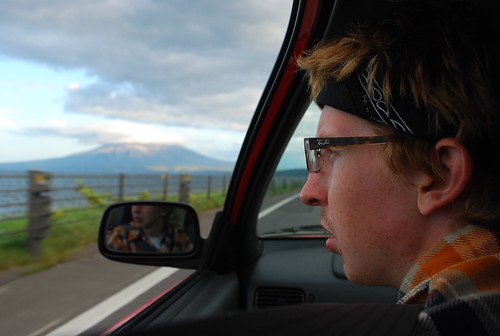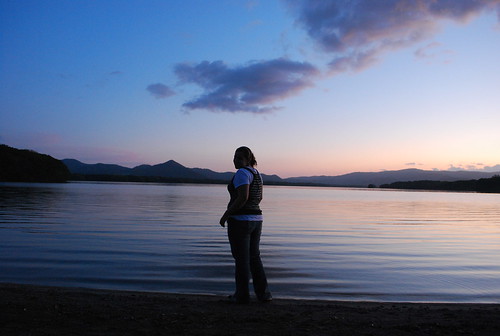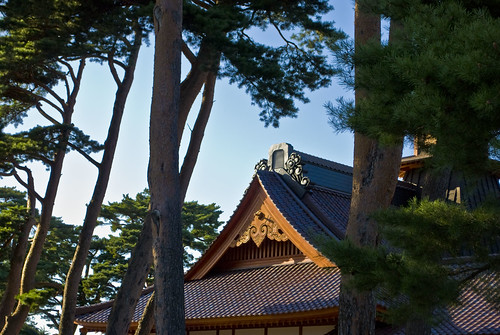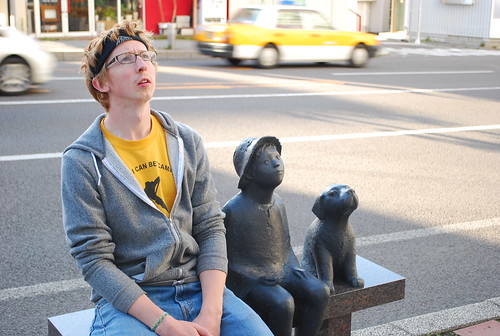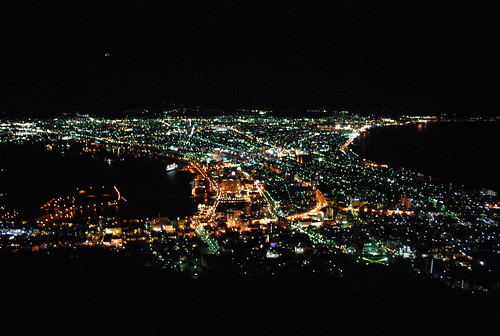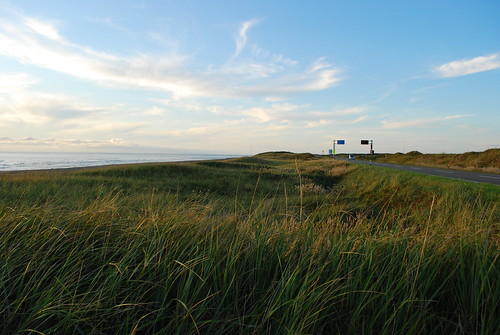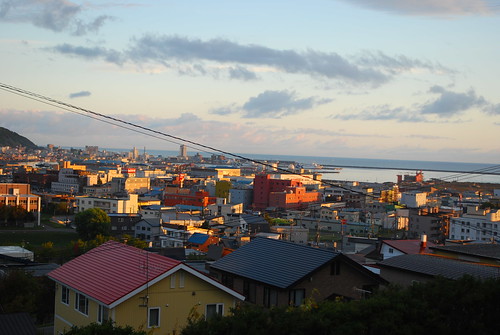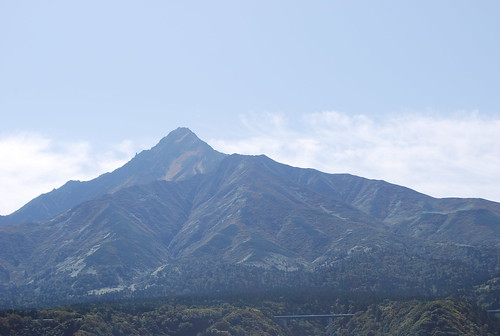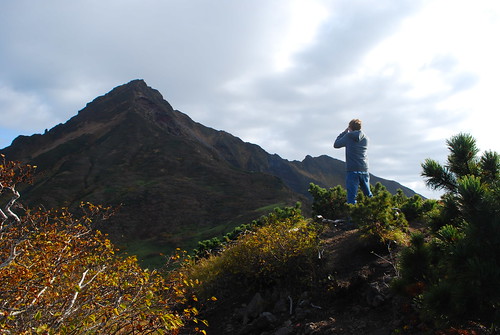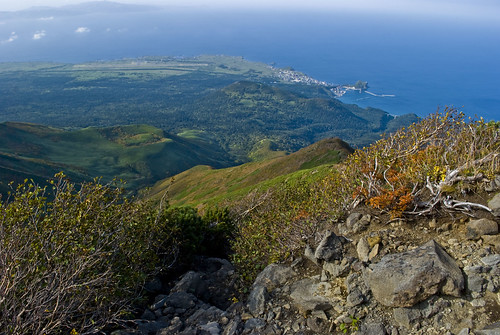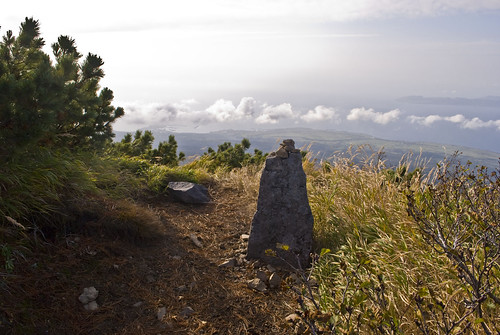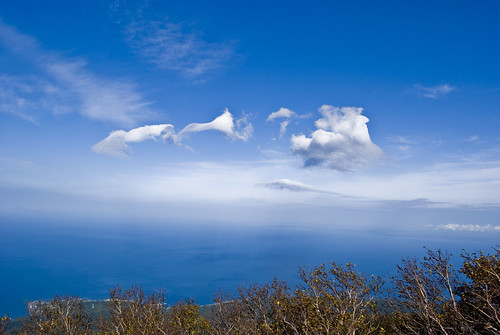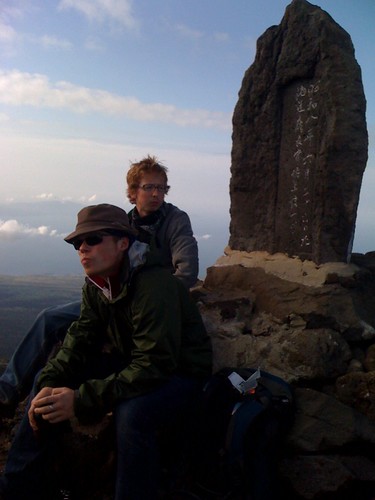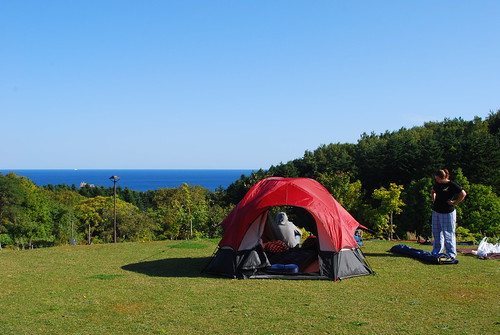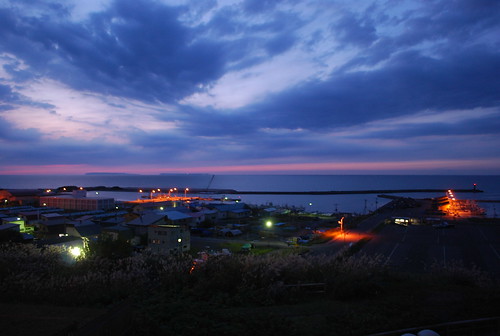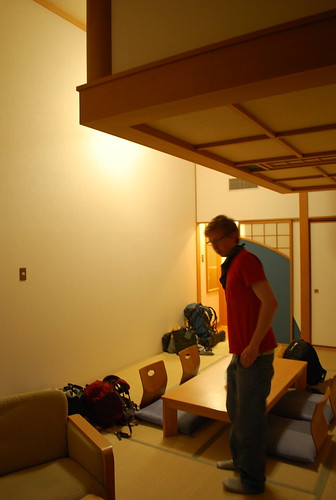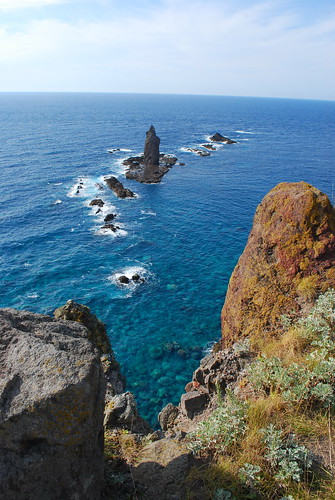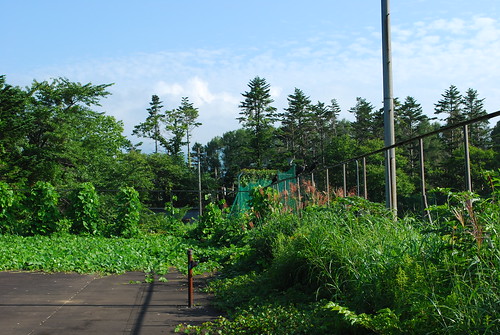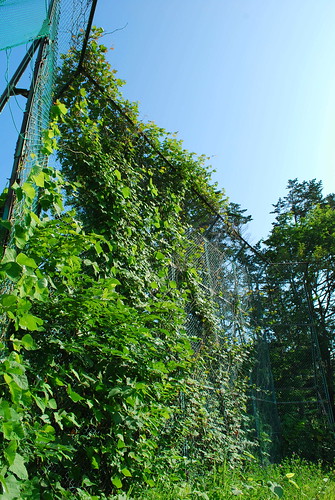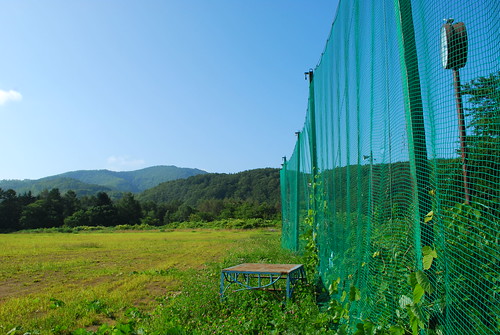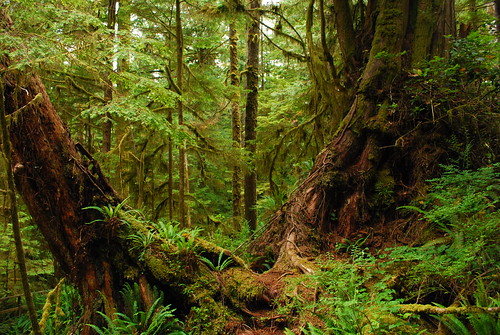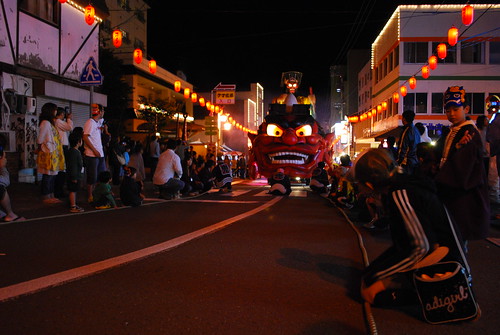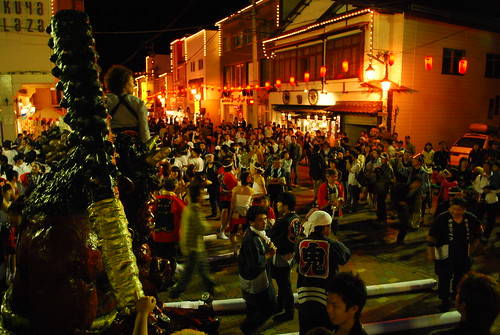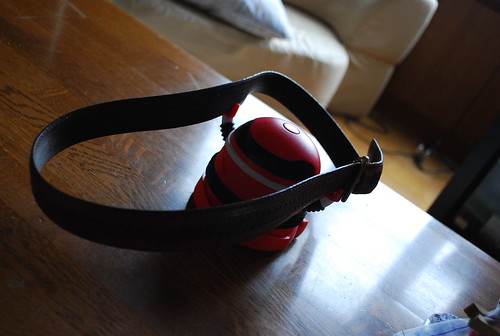Wednesday, September 30, 2009
Two Points Tour of Hokkaido
Monday, September 21, 2009
Two Points Tour, As it Happens
Mark, Lindsay, and I have officially kicked off our modified roadtrip in Hakodate at the bottom of Hokkaido. We're now heading to Wakkanai, at the north end of Hokkaido, via Sapporo.
Due to the wonders of the iPhone, we're able to post stuff to the web on the go. Best way to follow our progress if you're bored at work, check out the following album in my Flickr photostream:
http://www.flickr.com/photos/jonezer/sets/72157622098804285/
The roadtrip stuff starts at the picture Mark drew me of the two awesome bear-like Tanuki.
Friday, September 18, 2009
Through the fire...

Elementary Afternoons
When I'm at my elementary school, the most randomness seems to transpire on Friday afternoons in the fifth and sixth periods when I'm not usually booked to teach class.
Today was no different. Just after lunch, the first grade teacher rolled in and asked me if I wanted to participate in some kind of outdoor activity with the first graders. As my Japanese ability is currently resting somewhere around that of a three-year-old, I had no idea what she was asking me to do. However, the first graders are, pretty much, cuteness distilled into a substance so pure that it could probably fuel jet fighters—a substance so intoxicating and contagious that it has even rubbed off on their teacher, making her the cutest thing going in the staff room.
So, when she asked me to spend a period with her and her class, I didn't particularly care what we were doing. She could have been asking me to watch grass grow with her class for the period, and it still would have been the cutest 45 minutes I spent all day.
As she escorted me outside, the English equivalent finally occured to her, and she errupted victoriously with "BUTTERFLY!" "CATCH!". And, sure enough, when I got outside, I was greeted by a whole bunch of midgets, wearing their standard reversible red/white hats, armed with bug nets on poles twice their height. Most of them also had bug cages hanging around their necks, and these whipped around violently as the first of them caught sight of me and errupted in cries of "NIKORASU SENSEI!"
( I don't think I'll ever get tired of that. )
With an ichi-nensei holding each of my hands, and one latched somewhere on my shirt, we wandered around the back of the school and up the old concrete steps to the playing field. This wide staircase was once made of concrete, but it has since fallen into a kind of decrepit equilibrium that makes you wonder if it hadn't been swiped from some south american temple.
So this is where I spent my Friday afternoon: terrorizing bugs in Japanese with a band of first graders.
Wednesday, September 16, 2009
Epic Fail
Wednesday, September 09, 2009
A Sacrifice of Nines
Sorry. That’s the half-assed pagan in me poking out. One of the reasons I have a mild interest in the Japanese Shinto belief system is that some of the only religious ideologies that have ever made sense to me have been the ones that centered on worshiping nature. Venerating and paying tithe to the one thing that can be empirically shown to have given us life—the one thing that sustains us on a daily basis—is something I can believe in. Nature is also one of the sources of wonder that we can rely on to provide miracles on a regular basis. You can study the science of how a Douglas Fir—a tree that can grow to heights of beyond 100 meters—can manage to grow out of something as small as a seed on air, water, and sunlight alone, but the science of it can’t fully explain away the wonder required.
Sorry, once again. I half lifted that last bit from the latest book I finished reading. Though it has little to do with Japan, it’s underlying message aligns fairly well with the Shinto belief that there are spirits present in the land.
The book, published in 2005, was The Golden Spruce by Canadian author John Vaillant, a book that won the Governor General’s Nonfiction prize in 2005. I was put on to the book by Amy, my token Parks/Trees-and-rocks-and-shtuff friend, and she was put on to the book by a field course that she took in Haida Gwaii (once known as the Queen Charlotte Islands) last May. The book was required reading for the course, and, having now read the book, I can understand why. Golden Spruce aims to tell the history of resource exploitation in the Pacific North West (B.C. and Alaska) by arranging the story around a very real and very destructive act of protest that transpired on Haida Gwaii in 1997.
On January 27, 1997, a man named Grant Hadwin who was no stranger to the logging industry took a chainsaw to a unique Sitka spruce tree that was hundreds of years old and roughly 50 meters tall. It was known to local anglo residents of New Masset as “The Golden Spruce” and was a popular tourist attraction of their remote town. It was know to the Haida People of Old Masset as Kiidk’yaas and was a central element in their cultural mythos. And, in the eyes of Grant Hadwin, it was known to Macmillan Blodel, the logging firm who had bought rights to the majority of the timber on Haida Gwaii, as their pet tree and was a shinning gold medal of conservation behind which they could hide their destructive logging practices.
Around the central characters of the Golden Spruce and Grant Hadwin, author John Vaillant is able to weave a complex and informative narrative that is at once a biography of Hadwin, a snapshot of the cultural traditions of the Haida people, an ecological profile of the rainforests of the pacific northwest, a history of northwest logging, and a sobering view of the practices—and abuses—of the modern day logging industry. All of that mixed into one book seems like the perfect recipe for a dry, snore of a narrative, but Vaillant somehow manages to use Grant Hadwin’s story to pace all the facts that he imparts and to lend a sense of crisis—if not out-and-out suspense—to the narrative. By the end of the book, I felt both moved and informed by it. Vaillant had told this expansive, at times rambling, narrative, and in so doing he convinced me to rethink the way I use wood and paper products while also convincing me that I absolutely had to visit Haida Gwaii.
He also convinced me—unintentionally, I’m sure—that Grant Hadwin might have been right. But that’s something for the ramble below. For those of you not interested in the contemplation/rant, I’ll distill The Golden Spruce for you here:
If you love nature and want to believe in wonder, read The Golden Spruce.
If you’re ever been moved by something as simple as a forest or a tree, read The Golden Spruce.
If you’ve ever visited the temperate rainforests of British Columbia and been worried about the prospect of losing them, read The Golden Spruce.
If you’ve ever worried about the rights and legacy of the North American First Nations, read The Golden Spruce.
What was interesting, for me, about Grant Hadwin’s seemingly mad decision to cut down the Golden Spruce is that, from some perspectives, it makes sense. But, if I were to admit that I could agree with what Hadwin did, I would be in the minority. When I finished reading The Golden Spruce and googled “Grant Hadwin” to try to find some other photos of/interviews with the guy, all I could find were angry, opinionated articles about how heinous and dastardly a villain he was for cutting down a beautiful, old growth tree. But none of these articles/posts/blog entries mentioned anything about the thousands of people working in logging in the Pacific Northwest who cut down beautiful, old growth trees on the daily as part of their jobs. These angry posts talked about the salience of the Golden Spruce to the Haida cultural heritage, and they mentioned nothing of the importance of the forests of Haida Gwaii to that same heritage, forests that were appropriated from The People by the Canadian government and sold off to International Lumber. Everyone seemed happy to rally around those calling for Hadwin to be strung up for his crime, but no one seemed to be giving any thought to the message he was trying to communicate.
In the book, John Vaillant dredges up a curious historical factoid, mentioning how as the warriors of the Christian faith conquered Europe they would set fire to the sacred groves and forests where the indigenous peoples (many of them our own Germanic/Norman/Celtic ancestors) practiced their pre-Christian religions. He mentions in other places how it was common for these people to attribute particularly large trees to gods, and he even found a reference to a particular, symbolically grotesque means of disembowelment as the punishment for one who was so crude as to commit the crime of removing the bark of a living tree. These historical factoids, and many more like them referenced in the book, point to the fact that our ancestors once saw nature as holy and the forests as sacred.
But we’ve moved away from that now—we, the enlightened, who worship distant, faceless deities who we have created in our own image. And we worship them in buildings of wood and stone that we have hewn and remade to better serve our purpose. We’ve forgotten that the forests were once holy and that the largest of the trees were once our gods.
This could well have been this was the mysterious “great revelation” that Hadwin experienced (but the details of which he never imparted to another living soul) that set him on the path to the Golden Spruce—this sudden revelation that had been brewing in his subconscious as he worked in the logging industry for most of his life.
Maybe Grant Hadwin thought that this was the only way to make people realize the importance of the forests and the severity of the crimes against them. He elected to slay the most well known and most treasured of the old growth trees on Haida Gwaii to make people realize the wholesale slaughter that was going on, unseen, in old growth forests across British Columbia. In effect, he chose to kill Jesus to make the people realize that all of the other gods were already dead. He saw that our sacred groves had been gutted, and the only way people might start to realize it would be to see that destruction wrought on the only tree they seemed to care about.
As Vaillant reveals through scientific facts in the text, and as Grant Hadwin stated in his all-call fax after he made his attack on the Golden Spruce: the tree was a mutant. Where it was meant to have green needles, it grew yellow needles. This fact earned the tree its name, and it appears to be this fact that spared the tree (as well as some of the forest around it by proximity) from the MacMillan Blodel’s logging operations on Haida Gwaii. Hadwin refered to the tree as a circus freak, which seems apt as this mutant tree was spared while MacBlo was felling trees just as old, just as large, and just as majestic (if not older, larger, and more majestic) elsewhere on the islands. To keep this one tree standing in a token patch of spared forest while these other trees are cut down and sacked is somewhat akin to “preserving” a few token members of a certain species in a zoo while butchering and consuming the rest of their population. What Grant Hadwin’s attack on the Golden Spruce boiled down to was a question of “Why this tree? Why now?”
So that’s where I can agree with what Hadwin did. He staged a violent attack on a tree to prove a point, and it was shocking to all who had invested themselves in the life of that tree, but, in the end, people sat up and paid attention precisely because the tree meant so much to them.
And he was right.
Why this tree? Why does this one get to live while all the others just like it have to die? Because it is recognizable due to its mutation? Because we can’t see the forest: just the trees? Maybe the loss of this mutant could finally convince those who had invested themselves in the tree—maybe it would serve to give them a local frame of reference for the horrors that logging visited on their province regularly and had been doing for some time.
Where it gets a little harder to agree with Hadwin—and an area that I’d pretty much avoided thus far in all of this—is when you take into account the interests of the Haida People in the Golden Spruce. The Haida were the first inhabitants of Haida Gwaii and made the islands their home centuries before the first loggers or Anglo settlers ever arrived. The Golden Spruce had been woven into their myths and beliefs for generations. It was not a tree to them; it was the spirit of an ancestor who had taken the form of a tree. In a way, it was more alive to them than a typical tree is to us, and some believed that when it fell it would signal the end of the Haida nation. One could try to use the same arguments when contemplating the Haida’s investment in the tree: that they only developed their myths because the tree’s unique colouring made it stand out. One could try to rationalize the attack on the Golden Spruce as a wake up call for the Haida, hoping that it would galvanize them, the only people who had any real claim to the land of Haida Gwaii, and inspire them to be more protective of their island ecosystem.
In short, one could try to implicate the Haida as passive participants in all of this madness and try to suggest that the felling of the Golden Spruce was just a shot across the bow to rouse them to action, but it seems wrong. When Vaillant tells of the former height of Haida civilization before smallpox cut a swathe through their villages, when he paints the picture of the clear cutting that took place across the breadth of northern Haida Gwaii, it becomes clear just how much the Haida have lost already. It makes it hard to try to paint the loss of the Golden Spruce—a part of their myth and their culture—as a learning opportunity. Even Hadwin admitted when he was contacted directly by Guujaaw, the President of the Council of the Haida Nation, that if he had known of the Haida legend about the Golden Spruce, he may have thought twice about attacking it.
So, yeah, with the exception of the attack on the Haida people, I can understand what Grant Hadwin did when he cut down the Golden Spruce, and I can almost agree with it. This act of destruction has convinced me that I should look into joining Greenpeace—that when I get to a place where I’m thinking of buying a house, I should consider alternate building materials like bamboo and straw bale. I'll tell anyone who asks that my aforementioned half-assed paganness tends to manifest in a veneration for trees, and, looking at what Hadwin did, I think it takes some pretty big love for trees to have the stones to cut a big, beautiful one down to save the rest. It's the kind of statement/act of protest that I kind of wish I had the stones to do myself. And I hope, even if I do so in vain, that there comes a time when people can look at Grant Hadwin's attack on the Golden Spruce for what it was:
An Alarm Call.
A Necessary Sacrifice.
Not the Golden Spruce, but another Pacific Northwest reason to care about trees from Pacific Rim National Park.
Edit: Here's some supplementary video about the Golden Spruce from CBC's Six String Nation documentary:
Thursday, September 03, 2009
"Go to Hell" and some updates
Repeat.
Wednesday, September 02, 2009
Beacons
Down by the black waters of the harbour
I try to read beacons that shine in the night
just over the horizon;
Like small, dense, coastal cities
they sit, equidistant and equibright.
Were it not for the knowledge
that these waters flowed out to infinity,
joining the Sea of Japan,
I could believe the points of light brilliant metropolises
dotting the distant shore.
with giant bulbs, strung in lines, from bow to stern.
I wondered at the purpose of those chains of light,
and now I can picture it:
Them burning brightly in the night
Obliterating shadow on deck, for a wide radius
and summoning, from the depths
Fish, scores of fish
mothlike as they flock towards the glow
swirling upwards out of the unfathomable dark.

